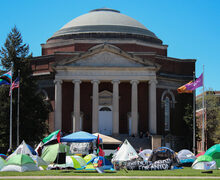Hendricks Chapel comforts many during times of crisis
Thomas Wolfe runs Hendricks Chapel. But in a funny way, he can’t escape the feeling that maybe the building actually runs him.
For two years, Wolfe — officially the dean of Hendricks Chapel since 1999 — has monitored Syracuse University’s spiritual pulse.
But for all he’s done, Wolfe knows it’s the building that can evoke a rallying call, a comforting sense of community or a reflective silence. History tells him just as much.
It sparked debate and enlightenment during the Vietnam War. It inspired togetherness after the Sept. 11 terrorist attacks. Since its construction in the 1930s, Hendricks Chapel has threaded SU through emotional and philosophical binds, nurturing a community longer than any individual ever could.
“Hendricks Chapel doesn’t just fall in the center of the university geographically,” Wolfe said. “It falls at the university’s center spiritually as well. It is central to the school’s sense of community.”
About 2,200 people filtered into Hendricks for a spur-of-the-moment, multi-faith service Tuesday, Sept. 11, 2002. For Wolfe, the alarming number of attendants is still somewhat of a mystery.
Wolfe and the nine Hendricks chaplains raced through that Tuesday morning in hectic disbelief. They met with university personnel in the morning and held an open service at 3 p.m.
“It was difficult at that point, because we didn’t know exactly what the extent of the tragedy was,” said Christine Day, the Episcopal chaplain. “Things happened so quickly we didn’t have time to publicize a service. But we did what we could.”
It seemed to be enough. A white billboard outside of the chapel announced the service and word leaked through the campus.
Wolfe set a single candle to burn at the front door, a long-standing tradition during times of intense conflict or tragedy. By 3 p.m. the chapel was filled to double its alleged capacity.
“There was a need for people to come together as a community and that occurred,” said university spokesman Kevin Morrow, who spoke briefly at the service. “Not only was every seat filled. The aisles were filled as well.”
“I like to think we were faithful to our task that day,” Wolfe said. “It was a nice moment for Syracuse University. I think pride would be a good word looking back on it.”
Wolfe remembers being so moved by the turn out, he almost couldn’t come up with words while on stage. So he gazed out at 2,200 faces in a building eerily quiet and opened with: “Don’t ever let anybody tell you your generation doesn’t care.”
“I almost felt drawn there,” said junior Julie Feeny. “I felt like I had to do something. It wasn’t a religious experience, but it was kind of comforting in a way.”
The service lasted for about two hours, but the building’s accessibility lasted much longer.
Wolfe and his staff adjusted their schedules to keep the chapel open at all hours of the night. Adjusted shifts forced some chaplains to work through the nights in case students wandered to the building to find solace.
For three days, Hendricks kept its lights on with a single candle burning in the opening doorway.
“That was the right way to respond,” Wolfe said. “That’s what Hendricks Chapel has often done.”
Prior to Sept. 11, two events most clearly molded Hendricks Chapel into the university’s unofficial community center.
On May 4, 1970, about 2,000 Syracuse students rallied around the chapel steps to listen to speakers urge an immediate student strike. Student leaders — most notably David Michael Ifshin, the student body president — expressed anger that U.S. military forces had entered Cambodia and renewed bombing of Vietnam.
That rally led to a week-long strike, one of the most notable collegiate protests to the Vietnam War.
“The chapel and its steps became a home to war debate,” SU history professor David Bennett said. “The chapel was used to discuss the war. It was a central point in that time.”
Students used the basement of the chapel as a home to war protests. Demonstrations extended from the chapel steps through the Quad.
“Any time things get squirrely, the chapel gets involved,” Wolfe said. “It’s a non-anxious presence, a forum for change and discussion. That was the case during the student strike.”
Nearly 20 years later, Hendricks evolved into a different role to fill a student body demand.
Thirty-five students studying in a Division of International Studies Abroad died when a bomb on Pan Am Flight 103 exploded over Lockerbie, Scotland, on Dec. 21, 1988. As soon as then-Dean Dick Phillips heard of the bombing, he lit the traditional candle and turned on the chapel lights.
Since the crash occurred on the last day of finals, most students had emptied out and headed home.
“But students instinctively came out of the woodwork,” Wolfe said. “The media went to the chapel balconies. Everyone knew right were to go. That’s just how it worked.”
“Hendricks tends to be the place people go to to remember people,” said Joan Deppa, a professor in the S.I. Newhouse School of Public Communications and a media expert on Pan Am Flight 103. “It’s almost the natural place to go. In times of widespread tragedy, we flock to it.”
But Wolfe most treasures Hendricks’ smaller successes, be it the support of a student who lost a parent or the resolution of a debate that divided a few members of the university community.
He’s decorated the chapel’s inside to make it seem inviting. He brings in concert series and art shows in an attempt to make each student feel he or she can find a place in Hendricks.
“You hope to create a comfortable environment that allows you to help people,” Wolfe said. “Then you can convince people to present vulnerability that will not be judged.
“It’s crucial that everyone feels welcome. Because in some ways with the chapel, we’re preserving a symbol of strength, community and enlightenment.”
Published on September 10, 2002 at 12:00 pm




